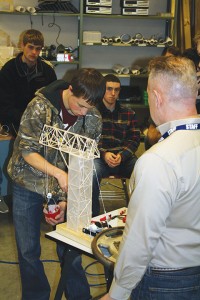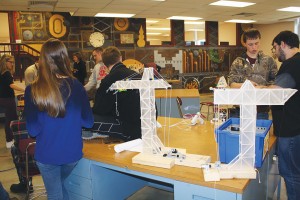The students of Tom Norris’ Principles of Engineering class pushed the limits of their student-designed and student-made mechanical cranes against the force of gravity on Tuesday, March 29.
Six groups of two to three students had to each design a balsa wood crane out of a set limit of supplies that included lightweight wooden sticks, wax paper, Lego pieces, plastic gear kits, and string. A number of factors in the design process can either make or literally break the project, so the groups over the course of five classes had to work together to come up with and construct a viable design that could withstand a minimum weight of two pounds.
“It really has to do with how you put the crane together, how you distribute the weight, and where you put the pulleys,” said Adam Perkins, a junior in the advanced engineering class. “It was all about the design.”
Perkins teamed up with Becca and Mallory Kiernan for the project. Following their design, they erected their crane using a set amount of wooden sticks provided to them by Norris and covered it with white wax paper as a laminate to stabilize the structure. They had to design and put together the motors out of gears they made themselves out of Lego pieces and plastic gear kits.
When it was their turn, the crane was placed on the desk with a large dumbbell weight to hold it down in place. Wires connected to the motor were hooked up to a yellow electrical box to power the small machines. A small number of weights were placed into a plastic cup that was then attached to a string ready to pull up the cup and bring it back down.
Perkins and the Kiernans managed to lift up to one pound, five ounces before their crane gave way and collapsed. In hindsight, they thought about what they could have done differently for better performance.
“We could’ve been a little bit less conservative with our balsa wood,” said Perkins. “But part of engineering is you are given a problem and using engineering, you have to solve that problem.” Failure, he said, was a part of the process.
Mallory thought the team was spot on with their pulley placements, but they failed to distribute the weight enough.
“And we could have laminated the weak spots of the crane a little bit more,” Mallory added.
Junior Davis Mathieu’s crane needed some adjustments to complete his trial, which was successful until the glue heated up from friction, causing minor damage.
“The crane can hold the weight,” Mathieu said as he carefully repaired the crane. “There’s just too much friction.”
Group by group, they presented their cranes, adding weight by the ounce after each successful trial until the cranes could pull no more.
The class mantra was “Go until it breaks!” as students and Norris marveled at the cranes capable of lifting over two pounds, like sophomores Caroline Murphy and Dillon McCarthy’s crane that lifted a whopping 4.25 pounds.
“It was unique the way we made the bottom wider than the top,” she said, pointing out the base of the crane. “And we designed a really unique pulley system … it just helped distribute the weight. We thought outside the box.”
Meanwhile, another crane made squeaking sounds as its motor spun and pulleys lifted and lowered the cup filled with ever-increasing weight.
Norris said the groups had to stick to a tight deadline and learn how to collaborate with each other during the design phase – a task that did not come easy at first.
“For the most part, I’m not sure they knew how to do that in a technical sense,” said Norris. “This group has done exceptionally well. A really nice job.”
The students also had to prepare a PowerPoint presentation about their project, and a total of six cranes were put to the test that day. It was the second time Norris had used this project in his class; however, this time it evolved from simple hand-operated pulleys to actual motors.
“I’ll definitely do this again next year,” said Norris.
By Jean Perry

